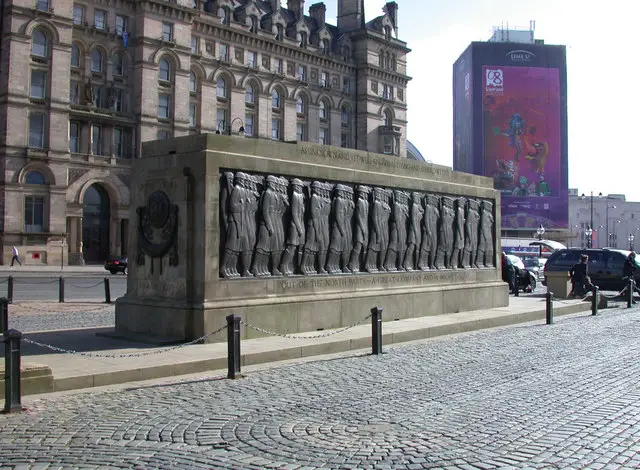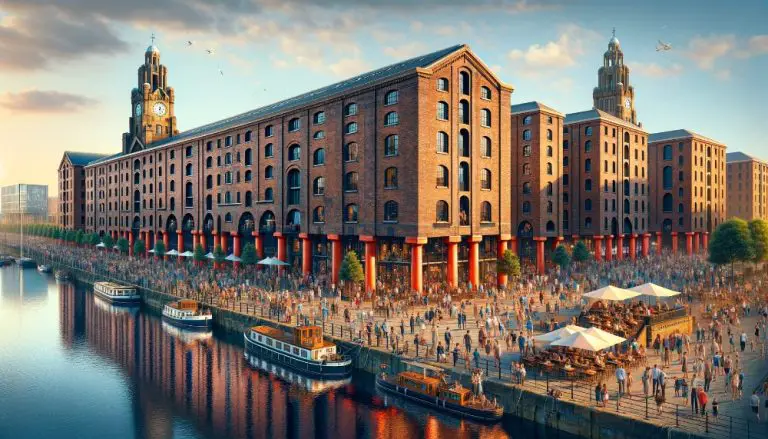Liverpool Cenotaph: A Significant WWI Memorial and Liverpool War Monument

Image Attribution: Keith Edkins, CC BY-SA 2.0, https://commons.wikimedia.org/w/index.php?curid=13378315
The Liverpool Cenotaph, located on St George’s Plateau in Liverpool, England, is a noteworthy memorial commemorating the sacrifices made during the First World War. Designed by Lionel Budden and adorned with exquisite low-relief bronze sculptures by Herbert Tyson Smith, this iconic cenotaph holds a special place in the country’s history. Let’s explore its location, architecture, history, significance, and more.
Key Takeaways:
- The Liverpool Cenotaph is a remarkable WWI memorial and war monument located in Liverpool, England.
- It was designed by Lionel Budden and features striking bronze sculptures by Herbert Tyson Smith.
- The cenotaph was unveiled in 1930 and later dedicated to include the Second World War.
- Its architectural significance, impressive location, and craftsmanship contribute to its Grade I listed building status.
- The Liverpool Cenotaph serves as a powerful symbol of remembrance and provides a space for reflection and commemoration.
Location and Architecture of Liverpool Cenotaph
The Liverpool Cenotaph is prominently located on St George’s Plateau, directly across from the magnificent St George’s Hall. This strategic positioning makes it a focal point for remembrance in the heart of Liverpool. The architecture of the cenotaph is a testament to its significance and the remarkable skill of its designers.
Constructed from Stancliffe stone and Yorkshire Silex stone, the Liverpool Cenotaph takes the form of a rectangular block mounted on a stone platform. The cenotaph measures 35 feet in length and stands 11 feet tall, while the platform spans an impressive 61 feet in length and 15 feet in depth.
One side of the cenotaph, facing southeast towards Lime Street station, features a poignant portrayal of mourners laying flowers and wreaths on a Stone of Remembrance. This depiction serves as a powerful visual symbol of the collective grief and respect for the fallen. On the opposite side, facing northwest towards St George’s Hall, the cenotaph showcases a riveting representation of marching troops. This depiction captures the sacrifice and unity of Liverpool’s soldiers during times of war.
The design of the Liverpool Cenotaph acts as a striking contrast to the vertical columns of St George’s Hall, creating a dynamic visual interplay between the two structures. The architectural and sculptural significance of the cenotaph has garnered widespread acclaim and contributes to its status as a Grade I listed building.
| Location | Architecture |
|---|---|
| St George’s Plateau, Liverpool | – Rectangular block of stone – Stone platform made of Stancliffe stone and Yorkshire Silex stone – 35 feet long and 11 feet high – Platform measures 61 feet long and 15 feet deep – Southeast face depicts mourners laying flowers and wreaths on a Stone of Remembrance – Northwest face shows a stream of marching troops – Acts as a striking contrast to the vertical columns of St George’s Hall – Praised for its architectural and sculptural significance |
History of Liverpool Cenotaph
The idea for a war memorial in Liverpool was first proposed in 1920 by the Lord Mayor of Liverpool. It took six years for the Liverpool Cenotaph to be completed, with construction starting in 1927 and the unveiling taking place on Armistice Day in 1930. The memorial was designed by Lionel Budden, who won an open competition with his horizontal design. The sculptural work was done by Herbert Tyson Smith, and the cenotaph was re-dedicated to include the Second World War in 1946.
| Year | Event |
|---|---|
| 1920 | Proposal of a war memorial in Liverpool |
| 1927 | Construction of Liverpool Cenotaph begins |
| 1930 | Unveiling of Liverpool Cenotaph on Armistice Day |
| 1946 | Re-dedication of Liverpool Cenotaph to include Second World War |
“The Liverpool Cenotaph stands as a solemn tribute to the bravery and sacrifice of those who served in the world wars. It is a symbol of remembrance and a testament to the resilience and unity of the Liverpool community.”
Lord Derby Unveils the Cenotaph
Significance of Liverpool Cenotaph
The Liverpool Cenotaph holds significant historical and commemorative value. It serves as a poignant reminder of the impact of the world wars on the city of Liverpool. The design and location of the cenotaph create a sense of monumentality, with its placement next to the grand St George’s Hall. The low-relief bronze sculptures by Herbert Tyson Smith are regarded as exceptional and powerful, depicting both the scale of loss and the unity of the nation. The cenotaph’s contemporary approach and high-quality craftsmanship further contribute to its significance.
Liverpool Cenotaph Ceremony
The Liverpool Cenotaph is a solemn and revered site that hosts a variety of ceremonies and events throughout the year. Of all the occasions held at the cenotaph, the most significant is the annual Armistice Day ceremony, which takes place on November 11th. This poignant event marks the end of the First World War and serves as a powerful tribute to those who sacrificed their lives for their country.
During the Armistice Day ceremony, a two-minute silence is observed, allowing participants to reflect on the devastating impact of war and honor the fallen heroes. Wreaths, adorned with red poppies, are solemnly laid at the base of the cenotaph by veterans, military personnel, and members of the public, each one representing a heartfelt tribute to the brave individuals who made the ultimate sacrifice.
“We gather here today to remember and honor the countless lives lost during times of conflict. The Liverpool Cenotaph stands as a powerful symbol of remembrance, a place where gratitude and solemnity merge. As I lay this wreath, I pay my respects to all those who selflessly fought for our freedom. Their sacrifice will never be forgotten.” – Anonymous participant
“Armistice Day is a time of reflection and unity, as we stand together to remember the immense toll of war. The Liverpool Cenotaph reminds us of the courage and resilience displayed by our servicemen and women. Today, we honor their memory and express our eternal gratitude.” – Anonymous veteran
This deeply moving ceremony is attended by individuals from all walks of life, including veterans, members of the armed forces, local community members, and visitors who wish to pay their respects. Together, they create a poignant atmosphere of reverence and unity, acknowledging the sacrifices made and keeping the memory of Liverpool’s fallen heroes alive.
Armistice Day at Liverpool Cenotaph
Opening Hours of Liverpool Cenotaph
The Liverpool Cenotaph is a public monument of great historical significance, open to visitors all year round. Whether you want to pay your respects, leave flowers, or simply reflect on the sacrifices made by Liverpool soldiers during the world wars, the cenotaph welcomes you at any time, day or night.
As an enduring symbol of remembrance and tribute, the Liverpool Cenotaph stands as a powerful reminder of the bravery and heroism displayed by those who fought in the world wars. Its 24/7 accessibility ensures that you have the opportunity to visit whenever it suits you best.
Feel free to take your time exploring the cenotaph’s intricate details, including its exceptional bronze sculptures by Herbert Tyson Smith. Take a moment to reflect and connect with the past, honoring the memory of those who made the ultimate sacrifice.
Whether you’re a local resident, a history enthusiast, or a visitor to Liverpool, the Liverpool Cenotaph is waiting for you. Plan your visit and experience the profound impact of war on the local community.
| Opening Hours | Days |
|---|---|
| 24 hours | Monday-Sunday |
Conservation of Liverpool Cenotaph
The Liverpool Cenotaph is a Grade I listed building, showcasing its exceptional historical and architectural significance. To preserve this iconic memorial, various conservation efforts have been undertaken. The listed building status is a testament to the cenotaph’s remarkable design, its impressive location, and the exceptional sculptural work by Herbert Tyson Smith. The conservation of the Liverpool Cenotaph is a vital endeavor to safeguard its historical and cultural value for future generations.
Importance of the Liverpool Cenotaph
The Liverpool Cenotaph holds immense importance as a memorial that commemorates the sacrifices of the Liverpool soldiers who lost their lives in the world wars. It serves as a focal point for remembrance and reflection, providing a space for individuals and communities to pay their respects and honor the fallen heroes.
The cenotaph’s significance extends beyond its historical context, playing a vital role in preserving the memory of Liverpool’s wartime past and the impact of conflict on the local community.
| Reasons for the Importance of Liverpool Cenotaph | Action |
|---|---|
| 1. Commemoration of Sacrifice |
|
| 2. Focal Point for Remembrance |
|
| 3. Preservation of Liverpool’s Wartime Memory |
|
Conclusion
The Liverpool Cenotaph stands as a powerful symbol of remembrance and tribute to the brave men and women who made the ultimate sacrifice in the world wars. Its striking design, location, and exceptional sculptural work make it a significant landmark in Liverpool’s history. The cenotaph’s ongoing conservation efforts ensure that it remains a place of solemn commemoration and serves as a reminder of the city’s unwavering gratitude to its fallen heroes.
As a Liverpool war monument, the Liverpool Cenotaph holds immense importance in preserving the memory of Liverpool’s wartime past and the impact of conflict on the local community. Its design context and architectural significance have earned it the Grade I listed building status, recognizing its historical and cultural value.
If you are in Liverpool, visit the Liverpool Cenotaph to pay your respects and reflect on the profound impact of war on the local community. Experience the somber atmosphere, admire the craftsmanship, and honor the sacrifices made by the Liverpool soldiers who bravely fought for their country.
FAQ
Where is the Liverpool Cenotaph located?
The Liverpool Cenotaph is located on St George’s Plateau in Liverpool, England.
Who designed the Liverpool Cenotaph and what is its architecture like?
The Liverpool Cenotaph was designed by Lionel Budden and is a rectangular block of stone on a stone platform made of Stancliffe stone and Yorkshire Silex stone.
When was the Liverpool Cenotaph unveiled?
The Liverpool Cenotaph was unveiled in 1930 as a tribute to those who lost their lives in the First World War, with additional dates for the Second World War added later.
What is the significance of the Liverpool Cenotaph?
The Liverpool Cenotaph holds significant historical and commemorative value, serving as a poignant reminder of the impact of the world wars on the city of Liverpool.
Are there any ceremonies held at the Liverpool Cenotaph?
Yes, the Liverpool Cenotaph is the site of various ceremonies and events throughout the year, with the most significant ceremony taking place on Armistice Day, November 11th.
What are the opening hours of the Liverpool Cenotaph?
The Liverpool Cenotaph is open 24 hours a day, seven days a week and is accessible to visitors throughout the year.
Is the Liverpool Cenotaph a listed building?
Yes, the Liverpool Cenotaph holds Grade I listed building status, recognizing its exceptional historical and architectural significance.
What is the importance of the Liverpool Cenotaph?
The Liverpool Cenotaph holds immense importance as a memorial that commemorates the sacrifices of the Liverpool soldiers who lost their lives in the world wars.
What is the significance of the Liverpool Cenotaph in Liverpool’s history?
The Liverpool Cenotaph stands as a powerful symbol of remembrance and tribute to the brave men and women who made the ultimate sacrifice in the world wars.
Source Links
- https://en.wikipedia.org/wiki/Liverpool_Cenotaph
- https://www.warmemorialsonline.org.uk/memorial/121229
- https://historicengland.org.uk/listing/the-list/list-entry/1073463
- The History Behind Liverpool’s You’ll Never Walk Along - February 16, 2024
- The History of Everton FC - February 16, 2024
- The History of Liverpool FC - February 16, 2024






